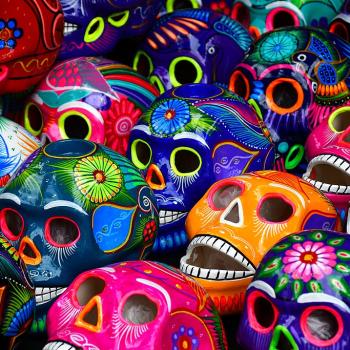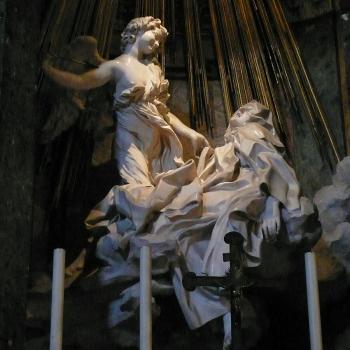I got to go to this biannual thing in order to read from my forthcoming novel, Punishment: A Love Story. During the conference a lot of the speakers made little videos answering questions about “the Catholic imagination,” and, because this conference had a certain self-awareness, one of the questions was basically, “Is this idea of ‘the Catholic imagination’ a useful or interesting category? Please share your beef with literally the whole premise of what we’re doing here.”
And yeah, I do have some thoughts on the conversations this phrase implies and the ones it tends to sideline or distort. But I’ll first say that my favorite panel was the one that was just relatively new writers reading from their work, and that seems like a great sign–that the most fun would be just hearing the work of Catholic writers. They were Phil Klay, Kirstin Valdez Quade, and Randy Boyagoda, and I chucked their books into my Amazon wish list with a quickness. (Valdez Quade also read an essay at the Latinx panel–lol the one panel, more on this in a moment–whose sweetness and humility charmed me even more than the intriguing excerpts of her story from the pov of the normal sisters of Christina the Astonishing.) So now, notes about “the Catholic imagination” and its shortcomings.
# Wait, no, I also dug Colin Cutler, who presented with me at the pre-conference, doing songs from his upcoming album that’s like, Nebraska-era Springsteen + Mary Gauthier + Inferno.
# Like all such conferences this one was relentlessly positive and encouraging about “imagination” and “story.” Why? I’ve unburdened myself recently twice about why these concepts are neutral at best, so I won’t belabor the point, except to say that any Catholic imagination will of necessity be smaller than the Church. At best we express what we can discern in Her wisdom but we see only a part of it. You may think “the Catholic imagination” sounds bigger and broader than the Catholic Church–it can even encompass atheists! But what the Church can do, which “the Catholic imagination” can’t, is correct where an individual (or cultural) imagination speaks falsely and shed light on the places where an individual or a culture doesn’t ever think to look.
# When I got to do my short video I noted that there are many Catholic imaginations. This is a conference centered on one tradition in Catholic writing: a twentieth-century white, English-speaking Roman Catholicism. Catholic imaginations formed by other traditions and cultures were often treated as special interests, or simply absent. I don’t know what a conference would look like that tried to braid together several traditions, giving each equal place. This conference probably came closest with Latino Catholicism. If we’re trying not solely to reflect the art already being created but to inspire better, weirder art, which can surprise and discipline “the American imagination,” that’s an extra reason to seek out voices that aren’t white, Western, or Roman Catholic. Byzantine Catholicism & the other churches in communion with Rome seem like good places to look for questions and beauties which the literary traditions on display here overlook.
I love Flannery O’Connor as much as the next person–I specifically thought the weird choral adaptation of “Everything That Rises Must Converge,” adapted by Karin Coonrod for the Compagnia de’ Colombari, was smart, funny, and haunting. But shouldn’t it feel bizarre to have one panel for Latino Catholicism in general? One panel for black Catholics? Two for “women”? This is nobody’s experience of the Catholic Church in America, come on.
Those panels aren’t the whole story; obviously Richard Rodriguez’s keynote, for example, was an expression of a browner Catholic imagination. But the panels do narrow our idea of what it is to be Catholic, or a Catholic artist. And they often distort the kinds of questions the panels’ ostensible subjects could raise. Why were the lady panels framed as discussions of marginalization, for example? Is that the most important or spiritually-rich experience women in the Church share?
What would be expressed if, instead of two lady panels, we had a panel about writing masculinity or manhood as a Catholic author? What if we assumed that people of color and women are central figures in the Church today, and in Her arts–since that’s sort of obviously true? We might end up with deeper historical discussions, discerning contemporary echoes of Spanish, French, and indigenous traditions. We might end up with a different set of political concerns, instead of the usual “thinking Catholic” (boo, hiss) dissent on the usual liberal/progressive issues.
# Here are some suggestions–you’ll have your own, I’m sure–for aspects of Catholic faith and practice which might be especially challenging for the specific mostly-white American literary culture around which this conference was shaped. Lol this is also my pitch for panels/events for next time, of course.
Silence. Contemporary literary culture tends to think in terms of being silenced, silence as oppression, rather than seeing silence as the soil of contemplation. I doubt we could get Cardinal Sarah to come to this thing, although I’d both pay for and sell tickets to that, but I’d love to see engagement with his writing on silence, and with the role of silence in a life seemingly given over to expression.
We heard quite a bit about women speaking out, which is fine, that is as Catholic as the Magnificat. We heard much less about men learning self-surrender, humility, meekness. In general this conference was more comfortable with liberation (a real and beautiful fruit of our faith) than with obedience, whereas it seems obvious to me that obedience is necessary for any artist who wants to have more to say than her own little individual ideas.
Richard Rodriguez’s keynote was… to me, it went beyond “a mixed bag” into “a mess.” (If you’re gonna name-check Ambrose St. John, get his name right; which was only a synecdoche for the speech’s larger (imo) problems of disorganization and undisciplined thought.) But it was also one of the only places where certain hard, strange Catholic ideas emerged. A friend paraphrased one of his points as, “Our country teaches us we have a right to happiness, while our Catholic faith tells us that suffering is the mark of being human.” Moreover, other speakers–rightly–spoke of cleansing in the Church, of reform and removal of abusive priests and the cover-up artists who protected them. We need honesty and justice, which for so long the leaders of Christ’s flock ignored. But Rodriguez reminded us that abusers are also members of the Body of Christ. They are us and ours.
On a personal note which ties together much of the above, I’d go to (or present at!) a panel on addiction and recovery in Catholic writing. That’s an arena where the seeming oppositions of obedience and liberation, suffering and relief, justice and reconciliation get worked out with life-or-death stakes. Where you’re really up against it: a good place for a writer.
Painting of St Anne teaching the Virgin Mary to read, from Andalusia, via Wikimedia Commons.












